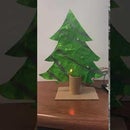Introduction: FUSED PLASTIC CHRISTMAS TREE WITH LEDS
The project is going to have you fuse together all your plastic bags into a usable material. You now have a new purpose to look at all those plastic bags stashed in your house. What colors do you want to use? Any cool patterns. This project really has you looking at plastic in all new ways.
Once you have your plastic it is time to fuse them together to create new material. From there you will add some LED lights and code your new Christmas Tree or any other design you wish to make. Don’t have an Arduino? What about a Raspberry Pi or Hummingbird Kit or Makey Makey? Use what you have!
Supplies
1. An Iron
2. Ironing Board
3. Parchment Paper
4. Plastic Bags
5. Scissors
6. LED's
7. Arduino...but you could use anything that you can code LEDs
Step 1: Directions for Fussing Plastic
Directions:
--I trimmed off all the handles and the seams of the plastic bags. I smoothed them out as well as I could. I used yellow bags as my base (because I only had one green bag).
--Set the iron between polyester and rayon, irons may vary so try a scrap 1st.
--Cut two large pieces of parchment paper that cover your cutting board...Whenever you fuse, the plastic will always be sandwiched between these 2 layers of paper. (The paper prevents the plastic from sticking to the board, and the iron.)
--I fused 1 bag at a time, which is 2 layers at a time. I used 3 yellow bags so it is 6 layers thick and then 1 green bag.
--On the ironing board, lay down one piece of parchment paper, then your bag, then the second piece of parchment paper.
--Now start to iron the top paper. Press firmly and keep the iron moving, don't let it sit in one spot for more than a second or two. After the front is melted together I flipped it over and ironed on the back as well.
--Once the yellow bags are done then I cut the green bag up and layered them as I fused it. I wanted it to be different layers to look more like a tree.
--Once I had the green plastic attached then I cut strips of a silver bag I had to add tinsel. The silver bag melted very quickly.
--Next, I traced a Christmas tree on the back and cut it out.
--I created a base by cutting a cardboard tube in half. I then cut a slit in the top to put the tree stand and I notched the back out for the wires of the LEDs. I hot glued that onto a cardboard base.
Step 2:
Next, I wired up the LEDs to the Arduino. To add the LEDs to the tree I put a small X slit and pushed the LEDs through the back. Mine stayed but if needed you could add a dot of hot glue so they don't fall out.
Step 3: Coding the LED's - Flashing Fast
Next I coded with the Arduino...but again you could use anything to make the LEDs flash. I used a code within the Arduino library to make them flash one at a time. You could also add more LEDs to this code...You would just have to add more ledPins and then make the index number bigger.
The LEDs flash very fast.
A copy and past of the above code:
int ledPins[] = {2,3,4,5,6,7,8,9};
void setup()
{
int index;
for(index = 0; index <= 7; index++)
{
pinMode(ledPins[index],OUTPUT);
}
}
void loop()
{
oneOnAtATime();
}
void oneOnAtATime()
{
int index;
int delayTime = 100;
for(index = 0; index <= 7; index++)
{
digitalWrite(ledPins[index], HIGH); // turn LED on
delay(delayTime); // pause to slow down
digitalWrite(ledPins[index], LOW); // turn LED off
}
}
Step 4: Coding the LED's - Flashing Slow
The LEDs on this code flashes slower. You could again add more LEDs. You would just add more pinModes and then add them into the loop using the same pattern as the rest of the pins.
A copy and paste of the above code:
void setup() {
// put your setup code here, to run once:
pinMode (2, OUTPUT);
pinMode (3, OUTPUT);
pinMode (4, OUTPUT);
pinMode (5, OUTPUT);
pinMode (6, OUTPUT);
pinMode (7, OUTPUT);
pinMode (8, OUTPUT);
pinMode (9, OUTPUT);
}
void loop() {
// put your main code here, to run repeatedly:
digitalWrite(2, HIGH);
delay(1000);
digitalWrite(2, LOW);
delay(50);
digitalWrite(4, HIGH);
delay(1000);
digitalWrite(4, LOW);
delay(50);
digitalWrite(6, HIGH);
delay(1000);
digitalWrite(6, LOW);
delay(50);
digitalWrite(8, HIGH);
delay(1000);
digitalWrite(8, LOW);
delay(50);
digitalWrite(3, HIGH);
delay(1000);
digitalWrite(3, LOW);
delay(50);
digitalWrite(5, HIGH);
delay(1000);
digitalWrite(5, LOW);
delay(50);
digitalWrite(7, HIGH);
delay(1000);
digitalWrite(7, LOW);
delay(50);
digitalWrite(9, HIGH);
delay(1000);
digitalWrite(9, LOW);
delay(50);
}

Participated in the
STEM Contest











